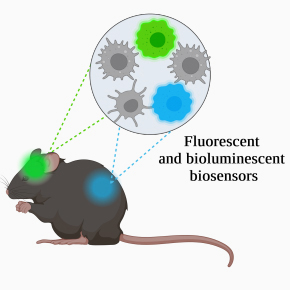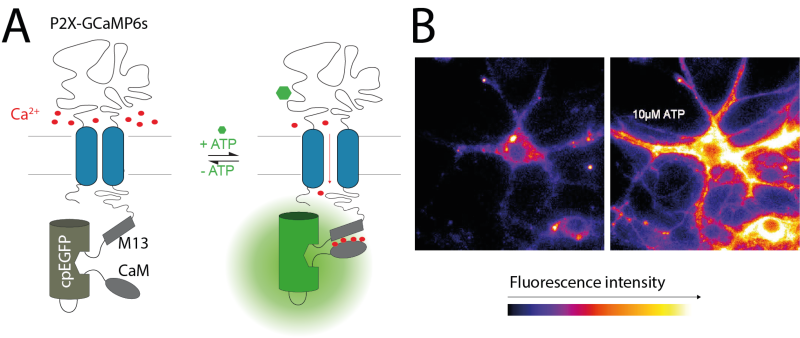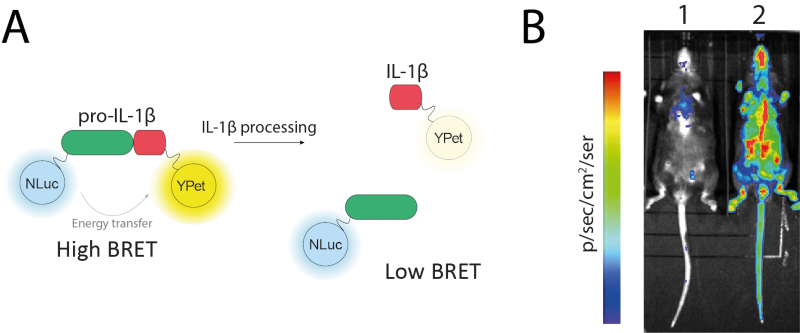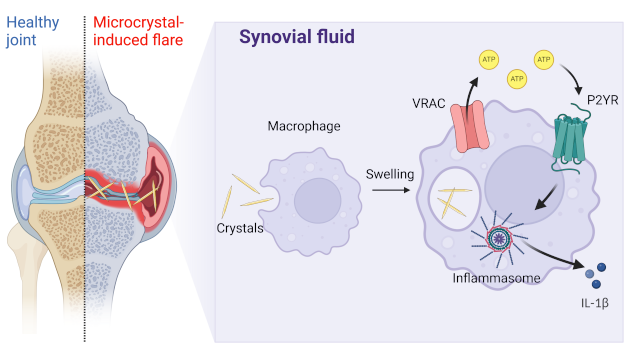Team François RASSENDREN
Purinergic signaling and brain inflammation
Project Development of biosensors for the characterization of inflammation
PRINCIPAL INVESTIGATOR

IGF staff involved
François RASSENDREN
DR CNRS
Nathalie LINCK
AI UM
Negar AHMADI
PhD student CNRS
Valentin GARCIA
PhD student INSERM
Paola NOBILI
IR INSERM

Our research theme is centered on the cellular mechanisms of inflammation. Thanks to the development of different biosensors and by combining the use of viral vectors and the use of transgenic animals, our objective is to be able to characterize in time and space key events of inflammation such as the release of IL-1β or extracellular ATP, particularly in the central nervous system.
Biosensors for ionotropic receptors and ATP receptors
We have developed fluorescent or bioluminescent biosensors making it possible to monitor the activation of different ionotropic receptors in real time. These tools are based on the fusion of receptors with luminescent probes sensitive to ionic variations near the pore. They are compatible with different types of approaches such as microscopy or high-throughput cellular screening.
The application of this strategy to P2X membrane receptors also allowed us to develop an ATP sensor sensitive enough to detect concentrations of the order of a nanomole of ATP, making this sensor a tool of choice for visualizing the release extracellular ATP.

(A) Schematic representation and principle of the ATP biosensor.
Following activation of the P2X receptor by extracellular ATP, an increase in GCaMP6s fluorescence is observed. (B) Detection of extracellular ATP by microscopy in hippocampal neurons expressing the P2X-GCaMP6s biosensor.
Main publications
• Chappe., et al. (2022) PNAS, Nov 16;119(46).
• Chappe., et al. (2021) Mol Pharmacol, Sep;100(3).
• Ollivier., et al. (2021) eNeuro, Jan 28;8.
Funding
• 2020-2023 ANR CANALBRET – Partenaire
• 2021-2024 ANR DIAPASON – Coordinateur (F. Rassendren)
Collaborations
• Yann Percherancier (Bordeaux)
• Thomas Grutter (Strasbourg)
• Etienne Audinat (Montpellier)
• Patrice Mollard (Montpellier)
Alumni
• Matthias Ollivier (PhD)
• Sandra Pierredon (IE)
Patents
• Y. Percherancier, V. Compan, F. Rassendren, M. Ollivier, Y. Chappe. WO 2021185759A1, 2021.
IL-1ß biosensors
Interleukin -1β (IL-1β) is a pro-inflammatory cytokine that plays a key role in the initiation of inflammation. However, the classic techniques used to detect IL-1β (ELISA and WB) do not allow the synthesis and maturation of this cytokine to be visualized in time and space. Using BRET technology, we have developed a biosensor making it possible to monitor in situ (at the cellular and in vivo level) and dynamically the bioactivity of IL-1β, opening new perspectives in understanding the different physiological and pathological roles of this cytokine.

(A) Schematic representation and principle of the IL-1β biosensor.
(B) Detection of the IL-1β biosensor in mice, in basal condition (1) or following the induction of inflammation (2).
Main publications
• Compan et al, (2023) Methods Mol Biol . 2696:47-53.
• Moutin., et al. (2020) Front. Synaptic Neurosci., 12:19.
• Compan et al. (2012) J. Immunol. 189:2131-7.
Funding
• 2019-2023 ANR NIFLURIL – Coordinateur
• 2022-2025 ANR 2020-MICROFLAMEAT – Partenaire
• 2023-2026 ANR 2020-INFLAMMANUP – Partenaire
Collaborations
• Alexandre Bennani (Dijon)
• Nathalie Ahrel (Montpellier)
Alumni
• Vincent Seube (Thèse)
• Eva Goetz (M1)
• Maxime Bonnet (M2)
• Anne-Laure Hemmonot (M1)
Purinergic signaling and inflammation
All of the biosensors developed in the laboratory allow us to decipher the cellular mechanisms of inflammation. In particular, our work focuses on the role of purinergic signaling and the VRAC anion channel in the activation of the NLRP3 inflammasome.

Mechanisms of activation of the NLRP3 inflammasome during joint inflammation caused by the presence of microcrystals in the joint.
Main publications
• Martin-Sanchez et al, (2023).J Cell Biol .;222(8).
• Baroja-Mazo A et al, (2019). Sci Rep.;9(1).
Funding
• 2022-2025 ANR CRYSTAL-IN – Partenaire
Collaborations
• Christophe Duranton (Nice)
• EA Hang-Korng (Paris)
Alumni
• Matthias Ollivier (PhD)


